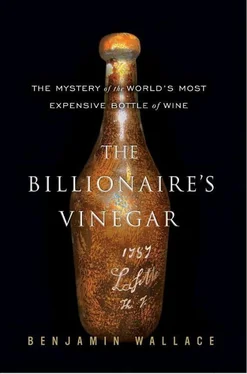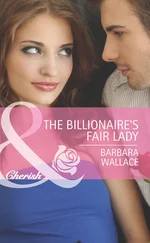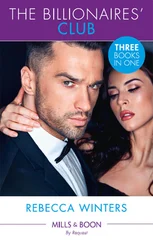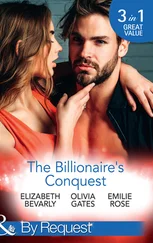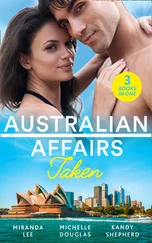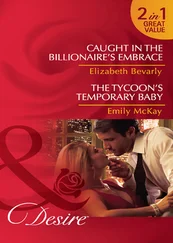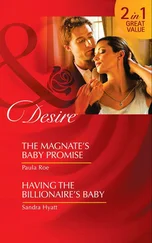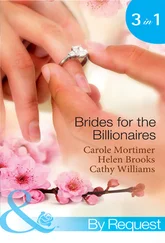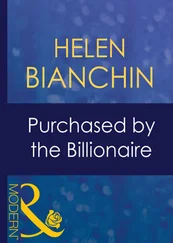In spite of Monticello’s doubts, and the unfortunate incident with the Forbes cork, the Mouton tasting six months earlier had benefited Broadbent and Rodenstock in two ways: it had authenticated the wine while adding to its value by finding it drinkable; and this new bottle was an Yquem—a Sauternes with a greater chance of surviving than a red wine—and of a vintage that had already been opened successfully. It had a track record, which Broadbent distilled as “perfect in every sense: colour, bouquet, and taste.”
Broadbent also happily reported that a German laboratory had analyzed the bottle opened earlier. “[T]he wax, the cork, and the wine have been rigorously examined by Professor Eschenauer whose methods are said to be the most acceptable, reliable and accurate,” Broadbent wrote in the catalog for the December 1986 sale. With the bicentennial of Jefferson’s visit to Bordeaux just months away, the moment seemed too perfect not to put another Jefferson bottle on the market.
As with the Forbes/Shanken match-up one year earlier, the contest on Thursday, December 4, 1986, rapidly narrowed to two serious bidders. After bidding £35,000, the owner of a wine shop in Syracuse, New York, was sure the bottle was hers, but then a buyer in the front row, an olive-skinned man with glossy ringlets of black hair and a small mustache, topped her and won the bottle for £39,600, or $56,628.
The buyer gave his name as Iyad Shiblaq, and identified himself to reporters as a Jordanian Muslim. He took pains to say that the bottle was not for himself, as his religion required him to be a teetotaler. He said he was buying the wine for “a friend of mine in New York” who had given him £50,000 to bid. Shiblaq wouldn’t name the friend, saying he had “no idea what he is going to do with” the bottle and that the friend simply wanted it “because of the label.” Shiblaq then rushed away without answering further questions.
This Jefferson bottle, too, set a record: it was the most expensive white wine ever sold. Like the Forbes purchase, it made news around the world. A transatlantic guessing game commenced as to the identity of the mystery buyer. On December 5, the New York Post ’s Page Six floated several names, including Malcolm Forbes, William Zeckendorf Jr., and Daniel Rose (both of the latter were Manhattan real-estate developers), investment banker Ed Marks, and Dodi Al-Fayed, son of Harrods owner Mohammed Al-Fayed, who years later would die in a car crash with Princess Diana. All denied it, and the Post concluded that none was the buyer.
“WHOOPS!” Page Six corrected itself the following day. The buyer was Al-Fayed, after all. “Wine is meant for drinking,” a Christie’s specialist named John Boodle had opined after the auction. “It is not a thing of beauty. You can’t hang it on the wall.” Now, Al-Fayed’s spokesman told Page Six, “He’s just going to keep it as if it were a piece of art.” Christie’s said it might auction another Jefferson bottle soon.
THE SHIBLAQ/AL-FAYED purchase came at a moment of broadening American awareness of Thomas Jefferson’s interest in wine. The first serious attention paid to his precocious connoisseurship had occurred in 1976, during the national Bicentennial, when the Wine Museum of San Francisco put on an exhibit called “Thomas Jefferson and Wine in Early America.”
Jefferson had planted scores of grape varieties at Monticello, and in many ways had foreshadowed the kind of systematic experimentation that eventually led Robert Mondavi to revolutionize American winemaking in the 1960s and 1970s. Now it was primarily citizens of his home state who led the way in dusting off this forgotten aspect of Jefferson’s life. In 1976 the Virginia Wine Growers Association, which would later break the news in the United States about the Rodenstock discovery, published its Jefferson and Wine anthology. The same year a winery called Barboursville opened in the shadow of the Blue Ridge Mountains, around the ruins of one of the five homes Jefferson had designed in his lifetime; it named a wine Octagon after the shape of some of the rooms. (Virginia’s wine industry would soon take off, expanding from six wineries in 1979 to forty-one in 1991 to 122 in 2006.) In 1982 a former National Security Agency linguist of Virginian extraction opened a winery called Monticello in the Napa Valley, and included a Jefferson Cuvée cabernet among its bottlings.
This rediscovery of Jefferson and wine came to a head in the mid-eighties, around the time of the record Forbes purchase. Monticello itself, in 1985, copied Jefferson’s planting of 1807, sowing twenty-one of the twenty-three varieties of white and red grapes (French, Italian, domestic) Jefferson had planted in the quarter-acre northeast vineyard. In 1986 a winery named Jefferson Vineyards came out with its first vintage; it was made from grapes grown on the neighboring land once worked by Filippo Mazzei, the Italian wine grower Thomas Jefferson had sponsored.
With the bicentennial of Jefferson’s 1787 visit to Bordeaux approaching, the scattered group of people with a particular combined interest in both wine and Jefferson arranged a series of celebrations. Travel agencies promoted tours of French wine regions visited by Jefferson. Treville Lawrence, editor of the VWGA Journal, approached Monticello about the possibility of either Hardy Rodenstock’s opening a bottle there or of the VWGA and Monticello jointly auctioning the bottle to benefit the VWGA. Monticello’s board of directors turned down the request. “The major problem relates to a doubt in our mind about the Jefferson connection,” director Dan Jordan wrote in a letter to Lawrence, “but the tradition here has also been to generate revenues in ways other than auctions.”
Edward Lollis, the American consul to Bordeaux, spent more than a year researching and organizing a slate of events that roughly tracked the dates of Jefferson’s visit. In a small triumph of amateur scholarship, Lollis deduced an explanation for Jefferson’s epistolary mention of seeing Latour’s vines, given the lack of evidence that Jefferson actually visited the estate. Latour’s vines grow near the Gironde, and Jefferson, an able flatterer, could plausibly imply he had glimpsed them as he sailed north along the river away from Bordeaux.
Things kicked off on March 28, 1987, with a black-tie dinner at the Château de Clos de Vougeot, in Burgundy, keynoted by the president of the Jeffersonian Wine Grape Growers Society in Charlottesville, Virginia. On June 1, the American ambassador to France traveled from Paris to Bordeaux, where a changing-of-the-cork ceremony was scheduled to take place at Château Lafite for a 1787 Jefferson bottle still in the possession of Rodenstock. The same day, Château Haut-Brion unveiled a plaque honoring Jefferson’s visit two hundred years earlier. In the afternoon, at the downtown building that had once been the Palais Royal and now housed the Chamber of Commerce, a Jefferson impersonator spoke, and the “world premiere” of an American Express tourism video, “Bordeaux at the Time of Jefferson,” was screened. In the final scene, filmed using a helicopter, a group of wine bottles rose into the sky.
Three weeks later, during Vinexpo, the massive trade show which brought the wine world to Bordeaux every other summer, Lollis welcomed visitors to the American consulate for a tasting of 140 wines from seventy-one American wineries. Jefferson had dreamed of this: the wines—whites downstairs, reds upstairs—came not only from Napa, but also from Missouri and some ten Virginia wineries. Christie’s, meanwhile, had announced that it would sell a third Jefferson bottle at Vinexpo.
ON THE FIFTH and final day of the trade show, two and a half hours into a four-and-a-half-hour, four-hundred-lot auction, Christie’s put the Jefferson bottle on the block. This one was a 1784 Margaux (the engraving said “Margau”) and was a 375-milliliter half-bottle shaped like a mallet. The fill came almost to the top of the shoulder. Michael Broadbent quoted from two Jefferson letters that referred to his buying 1784 Margaux, and opened the bidding at $21,600.
Читать дальше
